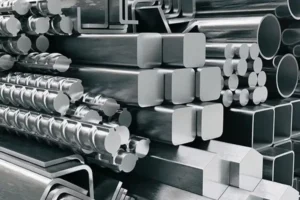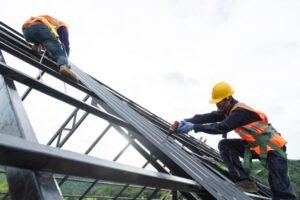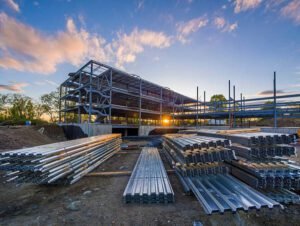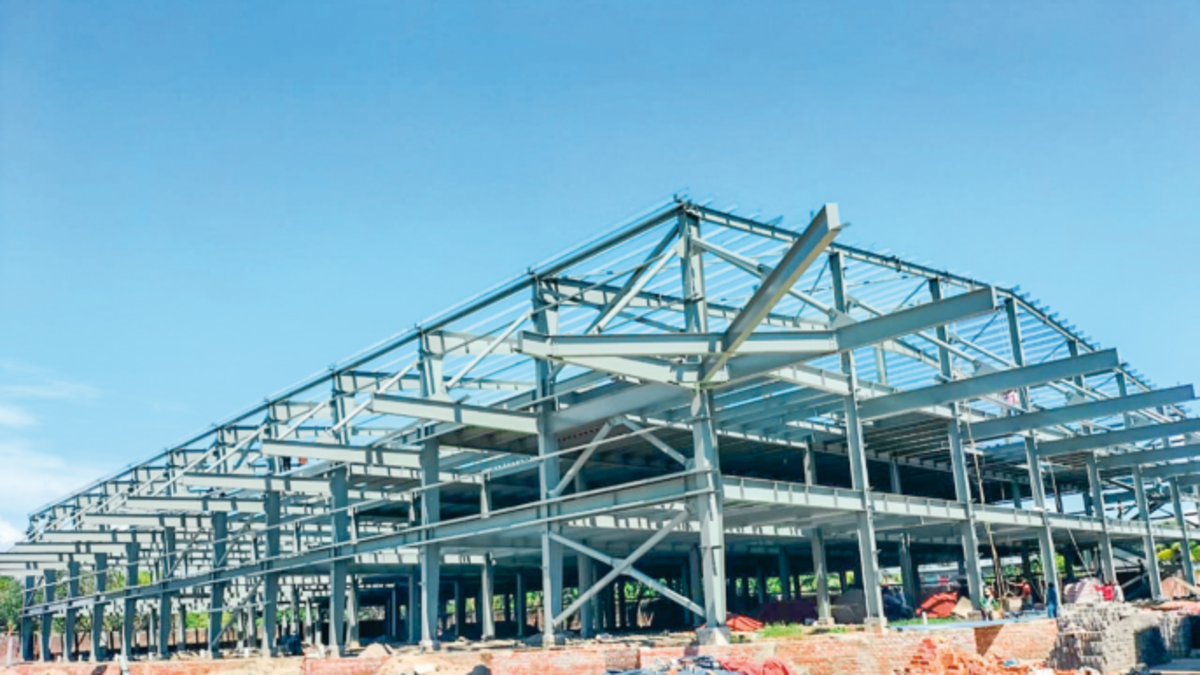Exploring the Growth of Steel Structure Building in Bangladesh
Steel structure buildings in Bangladesh offer durable, cost-effective, and eco-friendly solutions for industrial, commercial, and residential construction.
Bangladesh has witnessed a significant shift in its construction industry in recent years. The popularity of steel-structure buildings is on the rise, driven by rapid urbanization, technological advancements, and the growing need for durable and flexible construction solutions.
As cities like Dhaka, Chittagong, and Sylhet expand, steel structures are becoming preferred for commercial and residential projects.

Materials Typically Used in Steel Structure Building in Bangladesh
The primary material used in steel structure construction in Bangladesh is structural steel, which offers excellent strength and versatility. Common steel types include
- Mild steel: Widely used due to its affordability and workability.
- High-Strength Low-Alloy Steel: Offers greater strength with less weight, ideal for high-rise structures.
- Galvanized Steel: Coated with zinc to prevent rusting, ideal for areas exposed to the elements.
- Stainless steel: Used selectively for parts requiring high corrosion resistance.
In Bangladesh, steel structure construction typically relies on high-quality materials such as mild steel, high-tensile steel, galvanized steel, and specialized coatings to ensure durability, strength, and corrosion resistance. Forever Engineering LTD stands out in the industry by using only the best materials, guaranteeing superior performance, longer life spans, and maximum safety for every steel structure they build.
Advantages of Steel Structure Building in Bangladesh for Commercial and Residential Projects
Steel structures offer several notable advantages over traditional brick and concrete buildings:
- Speed of Construction: Steel structures are prefabricated off-site and assembled quickly on-site, significantly reducing construction time.
- Design Flexibility: Architects and engineers have more freedom to design unique and complex structures.
- Durability and Strength: Steel can withstand harsh weather conditions, earthquakes, and heavy loads.
- Cost-Effective for Larger Projects: For factories, warehouses, shopping malls, and multi-storied buildings, steel structures are more economical in the long run.
- Environmental Benefits: Steel is 100% recyclable, making it a more sustainable option compared to traditional materials.
- Lightweight: Compared to concrete, steel is lighter, reducing the load on foundations and enabling construction on difficult terrains.
For residential projects, modern steel-framed homes offer sleek, contemporary designs with open floor plans and energy efficiency.
Cost Analysis: Steel Structure Building vs. Traditional Construction in Bangladesh
When comparing costs, steel structure buildings might initially seem expensive due to material and fabrication costs. However, a detailed analysis shows:
| Category | Steel Structure Building | Traditional Construction (Concrete/Brick) |
| Material Cost | Higher initial steel cost but less overall waste | Lower material cost but more wastage |
| Labor Cost | Lower | Higher |
| Construction Time | Much faster | Slower |
| Foundation Requirements | Lighter structures need smaller foundations | Heavier structures require larger foundations |
| Durability & Strength | High strength, earthquake and wind resistant | Good strength but vulnerable to cracking |
| Maintenance Cost | Low | Moderate to high |
| Flexibility for Future Expansion | Easy modifications and expansions | Difficult and costly to modify |
Standard Sizes and Specifications of Steel Components Used in Bangladesh
Steel components in Bangladesh typically follow international standards, adjusted to local needs:
- Beams and Columns: Universal beams (UB) and universal columns (UC) commonly range from 150 mm to 600 mm in depth.
- Hollow Sections: Square and rectangular hollow sections range from 50×50 mm to 300×300 mm.
- Plates and Sheets: Steel plates used are often 6 mm to 25 mm thick.
- Purlins and Girts: C and Z purlins are used in roofing and wall cladding, typically in sizes from 100 mm to 300 mm.
- Bolts and Fasteners: High-tensile bolts conforming to ISO 898-1 Grade 8.8 or equivalent are standard.
- Coatings: Hot-dip galvanized coatings or paint systems (like epoxy or polyurethane) are applied for corrosion protection.
Engineers in Bangladesh follow codes such as the Bangladesh National Building Code and international codes like AISC and BS EN standards.

Maintenance Tips for Long-Lasting Steel Structure Building in Bangladesh
To ensure that steel-structure buildings remain in excellent condition for decades, regular maintenance is critical:
- Regular Inspections: Conduct inspections at least once a year to detect rust, corrosion, or structural damage early.
- Protective Coatings: Maintain protective coatings, and repaint exposed steel surfaces every 5-7 years.
- Moisture Management: Ensure proper drainage and waterproofing to prevent water accumulation, which leads to rust.
- Tighten Bolts and Fasteners: Over time, bolts can loosen due to vibrations. Regular checks are necessary.
- Roof Maintenance: Clean debris from roofing sheets and ensure that water outlets are not blocked.
Regular maintenance is essential for ensuring the longevity of steel structure buildings. Forever Engineering LTD provides expert maintenance services, ensuring your steel structures remain durable and efficient for years to come.
What Role Does Prefabrication Play in Steel Structure Building in Bangladesh?
The steel structure building industry in Bangladesh has evolved rapidly over the past decade, with prefabrication emerging as a major driving force. Prefabrication involves manufacturing structural components such as beams, columns, and trusses in a controlled factory environment and assembling them on-site.
This method brings significant advantages to the construction sector, including faster project delivery, reduced labor costs, improved quality control, and minimized material wastage. In a country like Bangladesh, where urban development is accelerating and land availability is shrinking, prefabrication offers an efficient solution for both commercial and industrial projects.
How Does Forever Engineering LTD Contribute to Steel Structure Building in Bangladesh?
Forever Engineering LTD plays a crucial role in advancing the steel structure building sector in Bangladesh. We specialize in designing, fabricating, and erecting high-quality steel structures for diverse applications, including commercial complexes, industrial plants, warehouses, and residential buildings. Forever Engineering LTD emphasizes:
- Innovative Design Solutions tailored to client needs.
- Precision Fabrication using advanced machinery and skilled manpower.
- Efficient Project Management ensures timely delivery and cost optimization.
- Commitment to Safety and Quality, following strict QA/QC protocols.
- Sustainability Initiatives, integrating energy-efficient designs and promoting recyclable materials.
Environmental Impact of Steel Structure Building in Bangladesh
Steel structure buildings are generally more environmentally friendly compared to traditional construction methods.
Firstly, steel is 100% recyclable; old steel components can be melted down and reused without losing strength. This greatly reduces the need for extracting new raw materials. Prefabrication further limits environmental impact by minimizing on-site waste, dust, and noise pollution.
Additionally, steel structures are energy efficient when combined with insulated panels and sustainable designs, lowering operational carbon footprints over a building’s lifetime. However, the production of steel does require significant energy, which is why there is a growing emphasis on using green steel made through cleaner technologies. In Bangladesh, sustainable steel sourcing and eco-friendly building designs are becoming more important to align with global climate goals.

Common Foundation Systems Used for Steel Structure Building in Bangladesh
The foundation of any structure is critical, and steel buildings in Bangladesh commonly use foundation systems that balance load distribution with soil conditions. The most frequently used systems include
- Isolated Foundations: Suitable for low- to mid-rise steel structures, where each column rests on an individual concrete pad.
- Raft Foundations: Used when soil conditions are weak and a large load needs to be spread over a wider area.
- Pile Foundations: Necessary for large, heavy structures or areas with soft soil. Precast concrete piles or cast-in-situ piles are commonly used.
- Combined Footings: Employed when columns are close together, combining their loads onto a single footing. Each foundation type is selected based on site-specific soil investigations and load calculations to ensure long-term stability.
How is Structural Safety Ensured in the Fabrication and Erection of Steel Structure Building in Bangladesh?
Structural safety is a top priority in steel construction, and several measures are taken during fabrication and erection:
- Strict Quality Control: Steel members are fabricated under controlled factory conditions, ensuring precise dimensions and weld quality.
- Material Testing: Raw materials and finished components undergo rigorous testing for strength, ductility, and corrosion resistance.
- Certified Welding and Bolting: Only qualified welders and certified fasteners are used during fabrication and erection.
- Compliance with Standards: Projects adhere to codes like the Bangladesh National Building Code, AISC, and international safety standards.
- On-Site Inspections: Engineers regularly inspect on-site assembly to verify structural alignment, bolt torquing, and weld integrity.
- Load Testing and Simulations: Advanced software simulations and sometimes physical load tests are conducted before final approval.
These practices ensure that steel structures in Bangladesh can withstand natural forces like cyclones, earthquakes, and heavy loads safely.
The Future Technology of Steel Structure Building in Bangladesh
The future of steel structure building technology in Bangladesh looks highly promising. Key trends shaping the industry include:
- Adoption of Smart Building Technologies: Integration of IoT sensors for real-time monitoring of building health.
- Green Construction: Use of environmentally friendly materials and designs that meet global green building certifications.
- Modular Construction: Expanding use of fully prefabricated modules that can be quickly assembled on-site.
- Advanced Materials: The rise of new alloys and composites that offer greater strength, durability, and corrosion resistance.
- Automation and Robotics: Prefabrication facilities are increasingly using automation for welding, cutting, and assembly to boost efficiency and reduce human error.
The future of steel structure building technology in Bangladesh looks promising, with continuous advancements in design and efficiency. Forever Engineering LTD embraces the latest technologies, ensuring cutting-edge solutions for every project.

